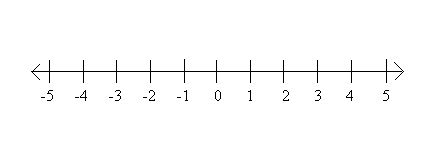
What does that word really mean to students? The number line is on a piece of paper that they can use if they understand it. I know when I was a students in middle school, I did not understand the number line fully until I played the game "Human Number Line" in my college class.
Human Number Line Game
First, you will create a number line on the floor of the classroom or gym. The number line can be as long or as short as you wish and be created with tape or even string. The number line should include negative and positive number along with a zero. The numbers should be the same difference apart and close enough the students are able to take a step and be able to land on the next integers. Below is a picture from a blog that has a similar game.

The game will teach students how to add and subtract positive and negative integers. You will first allow the students to play with the number line by telling them these simple rules:
1. start neutral (feet facing a wall) at the first number
2. the operation sign (addition or subtraction) point your feet towards the side of the the sign
Addition = positive side of number line
Subtraction = negative side of number line
3. if the number is positive walk forward or if the number is negative walk back wards
4. when done counting, put you feet at neutral
An example:
Start at 5 with neutral feet, point feet towards the negative side (subtraction), walk backwards 7 steps (-7), land on 12 with neutral feet.
5-(-7)=12
One variation:
You could have one student move around the number line with an equation in their head and have the other students guess the equation that the student on the number line moved. This will show the connection between the operation signs and the number line. Next, a group students could come up with an equation and/or story and then the rest of their classmates have act out the equation/story on the number line.
Second variation:
In my college class, we played a game on the number line with a deck of cards. Take a deck of 52 cards and take out the face cards (Jack, King, Queen). A red card symbolizes a negative number and a black card represents a positive number. Pass out the remaining cards to each player, and have each player have the cards facing down. To start the game, each student will stand at zero and flip up their first card, the student with the smallest number will choose what side of the number line they wish to reach the end (negative side or positive side). The other student will be given the other side of the number line. The students then can give (subtraction) their number to the other student or move (addition) their number. This will continue until one student reaches the other end of the number line and win the game!
Example:
Student 1 and student 2 are starting at zero. Student flips up a -3 and student 2 flips up a 7. Student 1 has the smallest number between the two students and chooses to reach the end of the positive side. Then student 2 will have to reach the end of the negative side. The next flip, student 1 flips up a 4 and student 2 flips up a -9. Student 2 (going towards the negative) says he/she will "add -9" to himself/herself (0+-9=-9). While student 1 (going towards positive side) will "add +4" to himself/herself (0+4=4). Next turn, student 1 flips up a -6 and student 2 flips up a -4. Student 1 (going towards positive side) and will "subtract -6" from student 2. Now student 2 will have to move -9-(-6)=-3. Now student 2 will "add -4" to himself/herself (-3+-4=-7). This continued until Student 2 won!
Nice write up!
ReplyDeleteClear, coherent, complete +
Content&consolidated would both be even stronger with a comment answering how did this help your understanding of the number line?
Nice description of the different opportunities to use a number line in the classroom, especially the games. I've actually used the number line to help a student I tutor and he said it really helped to see how the operations affect the numbers. So I think it's a great resource for students who are learning to subtract and add with negatives. Good job!
ReplyDelete